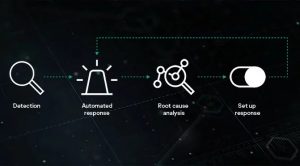Endpoint Detection and Response EDR: Preventing Cyber Attacks With Its Multiple Approaches.
Updated on July 20, 2023, by OpenEDR
In today’s digital era, where the world is connected digitally every existing and flourishing organization relies completely on technology as well as interconnected networks. With the advancement of technology, the possibility of cyber-attacks increases at a faster rate. To minimize the impact of cyber-attacks and prevent their occurrence in the near future Endpoint Detection and Response (EDR)plays a very important role.

How does Endpoint Detection and Response (EDR) help the organization?
EDR helps the organization in multiple ways like,
- Maintains Confidentiality of the organization
- Protects sensitive information
- Save from the financial losses
- Hinders reputational damages
- Avoids legal consequences
To mitigate the above-mentioned risks, Endpoint Detection and Response (EDR) is an effective source. It helps in protecting the vitality of the organization by effectively detecting, analyzing, and responding to security incidents at the endpoint level.
Endpoint Detection and Response (EDR) is an advanced cybersecurity approach that puts an emphasis on protecting the organization’s endpoints, such as desktops, laptops, servers, and mobile devices from the cyber threats that are evolving in the technological atmosphere. In the case of providing the best protective solution to the endpoint’s security, traditional antivirus solutions often fall short in accurately responding to complex attacks. In that scenario, Endpoint Detection and Response (EDR) is an essential component of an organization’s security posture.
The question that arises is how the Endpoint Detection and Response (EDR) works. Well, EDR solutions continuously monitor the occurrence and activities at the endpoint level of any organization. It collects on the potential threats. The service providers employ advanced and effective techniques to identify suspicious behavior or indicators of compromise (IOCs) to find the root cause of the threat. By analyzing and thoroughly examining every aspect of the data, they enhance the optimal solution to prevent malicious activities. They also improve their services at:
- Malware infection
- Fileless attacks
- Unauthorized access attempts
- Data exfiltration
Endpoint Detection and Response (EDR) uses various approaches such as machine learning algorithms, behavior analysis, and threat intelligence to identify the unknown threats that can hinder the working of any organization’s functionality. These approaches help organizations to identify and work accordingly to the uprising threats in real-time., and minimize the dwell time of attackers within their systems. Endpoint Detection and Response (EDR) provides detailed visibility into endpoint activities that allow the organization to reduce the overall impact of cyber attacks through:
- Investigate incidents
- Trace attack paths
- Contain compromised endpoints
- Remediate affected systems.
Among the other beneficial factors of Endpoint Detection and Response (EDR), it offers granular visibility into the endpoint activities of the organization which allows them to monitor various aspects like:
- Software installation
- Patch level
- User behavior
- System configuration
With the aid of continuous assistance, the EDR tools can spot suspicious activities like privilege escalation, lateral movement, and data exfiltration, even in the absence of known signatures or indicators. Additionally, Endpoint Detection and Response (EDR) helps the organization meet the requirements of amendments by providing by providing extensive logs and endpoint trials of endpoint activities. The assistance & visibility provided to the organization to enforce the
- Protective security policies
- Detect the violation of the Policies
- Proactively address vulnerabilities
Endpoint Detection and Response (EDR) has emerged as a vital solution for protecting an organization from the everlasting landscape of Cyber threat. Endpoint Detection and Response (EDR) solutions help enterprises to proactively safeguard their systems, data, and reputation by providing improved threat detection, real-time incident response capabilities, and enhanced endpoint visibility and management.
Why choose EDR security from OpenEDR®?
There are various reasons to choose Endpoint Detection and Response (EDR) from OpenEDR®, like,
- It identifies the source of cyber attacks to provide optimal solutions.
- It can detect malware threats that are missed by traditional antivirus systems and applications.
- Not only does it eliminate the threat from the network, but it also isolates the infected system to prevent it from propagating to other endpoints.
- It reacts promptly to an impending attack, which considerably aids in preventing severe damage to the firm network’s security.
- It investigates whether the threat is real or a false positive. It investigates the questionable elements before alerting the security staff.
Conclusion
To safeguard the optimal functionality of any organization, OpenEDR® is the one-stop solution. With our Endpoint Detection and Response (EDR), we detect the threat, examine its source, and provide the necessary solution to the organization.
In other words, we are integrated into a comprehensive cybersecurity strategy that includes robust perimeter defenses, network monitoring, user awareness training, and timely patch management.
Our prime goal is to keep every existing as well as uprising organization ahead of the consequences arising of the cyber attract. We ensure that when an organization (s) chooses our Endpoint Detection and Response (EDR) solution, they can relax the disturbance caused by the mischievous activities of the potential cyber attacker.
See Also: